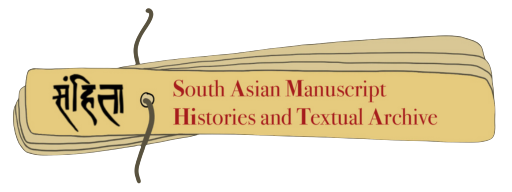Manuscripts
Search Filter
Kaṇṭhāvatāra
EAP1023/25/14 Language : Sanskrit Scripts : Newari
This is a medieval text in Sanskrit written with Pracalit Newari script. It deals with various religious matters. This is a Shaiva Tantric text. The whole story in the text is retold by God Bhairava.
Rāghava Pāṇḍaviya Prakaraṇa
EAP1023/25/15 Language : Sanskrit Scripts : Newari
This Sanskrit text is an epic dealing with Hindu religious stories. Mainly it deals with the event of Ravana Badh in the Ramayana [Rāmāyaṇa]
Kālikā Purāṇa
EAP1023/25/17 Language : Sanskrit Scripts : Newari
This is a Purana manuscript in Sanskrit language. It is written with Pracalit Newari script. This is about Goddess Kali.
Prabodha Candrodaya
EAP1023/25/18 Language : Sanskrit Scripts : Devanagari
Prabodha Chandrodaya or 'Rise of the Moon of Knowledge,' is a Sanskrit Drama written by Krishna Mishra. It is a play in six acts dating from about the end of the eleventh century. It depicts the battle between Mahamoha ('great delusion') and Viveka ('discrimination) in the mind of man (Purusha) through the conflict between Vedic and non-Vedic traditions, and between figures like ahamkara (ego), krodha (anger) and santi (peace).
Sanskrittattvabodhinī
EAP1023/25/19 Language : Sanskrit Scripts : Devanagari
Story of a brahmin Devadattasharman from Vishala (in modern Bihar) who is entrusted with the education of a prince, and whose son Gopibhattasharman impresses the court with his erudition. The author says his purpose in telling the story is to make Sanskrit easily accessible to young people.
Mudrārākṣasa
EAP1023/25/20 Language : Sanskrit Scripts : Newari
The Mudrarakshasa is a Sanskrit play by Vishakhadatta on the ascent to power of the king Chandragupta Maurya. The play is not entirely fictional. It is dated variously from the late 4th century to the 8th century CE.
Raghava Pānḍaviya Mahākāvya
EAP1023/25/21 Language : Sanskrit Scripts : Devanagari
This Sanskrit text is an epic dealing with Hindu religious stories. Mainly it deals with the event of Ravana Badh in the Ramayana [Rāmāyaṇa]. The text has marginal notes. A pencilled note on the cover refers to the tika (commentary) by Shashidhara.
Mahākala Saṁhitā
EAP1023/25/22 Language : Sanskrit Scripts : Newari
Mahakala Samhita is a Tantric text related to Goddess Mahakali. It is believed to have been composed in the 10th century and is ascribed to Adinath. Mahakali is the chief goddes of the whole tantric system based on the Vamacara practices and manifests in 51 different female forms.
Śiśupālavadha
EAP1023/25/24 Language : Sanskrit Scripts : Devanagari
The first ten cantos of Shishupala Vadha, one of the six Sanskrit mahakavyas (epic poems). Composed by Māgha in the 7th or 8th century, it has 20 cantos of about 1800 highly ornate stanzas. The manuscript includes marginal notes written in ornamental style reflective of Magha's own.
Kālikā Sahasranāma Stotra
EAP1023/25/25 Language : Sanskrit Scripts : Devanagari
This is the stotra or the prayer to Shree Kalika Devi (Goddess Kali) who is the remover of darkness. As the name indicates, it is a thousand-name hymn.
Jayākhya Saṁhitā
EAP1023/25/27 Language : Sanskrit Scripts : Newari
Jayakhya Samhita is one of the three gems of most important Samhitas. The other two are Satvata Samhita and Pushkara Samhita. They are Pancharatra texts. This work is one of the cardinal texts of Pancaratra literature. It deals with creation, practice of Yoga and mantropasana, ritual worship and fire ritual, initiation, codes of conduct for Vaishnavas; and expiations of sins.
Jayākhya Saṁhitā
EAP1023/25/28 Language : Sanskrit Scripts : Newari
Jayakhya Samhita is one of the three gems of most important Samhitas. The other two are Satvata Samhita and Pushkara Samhita. They are Pancharatra texts. This work is one of the cardinal texts of Pancaratra literature. It deals with creation, practice of Yoga and mantropasana, ritual worship and fire ritual, initiation, codes of conduct for Vaisnavas; and expiations of sins.













